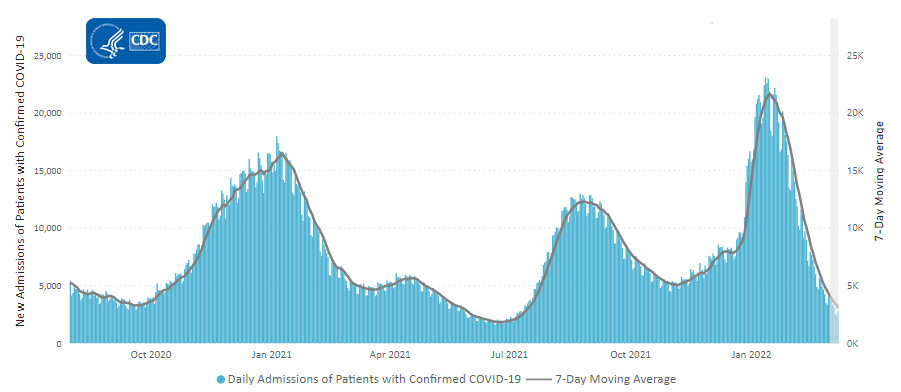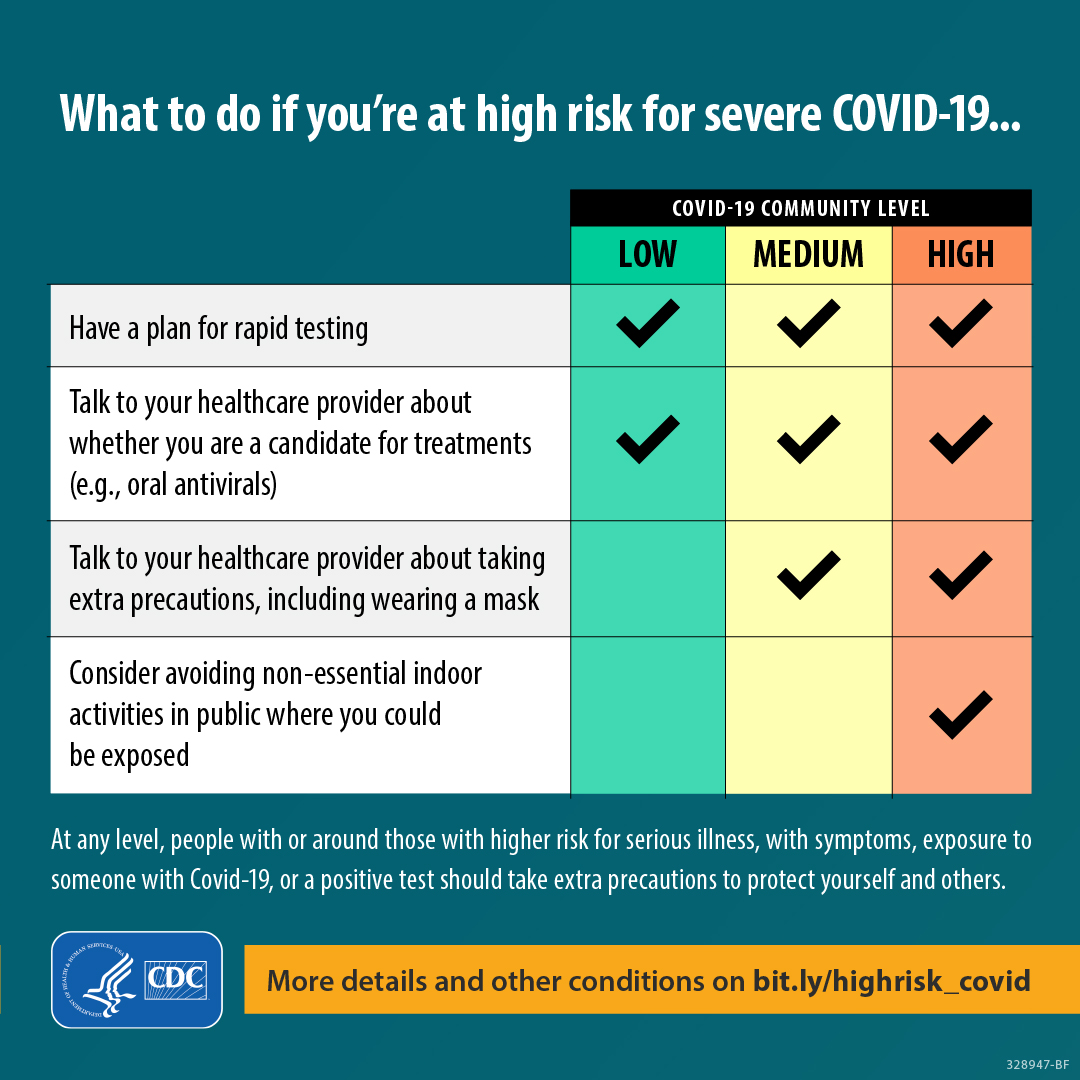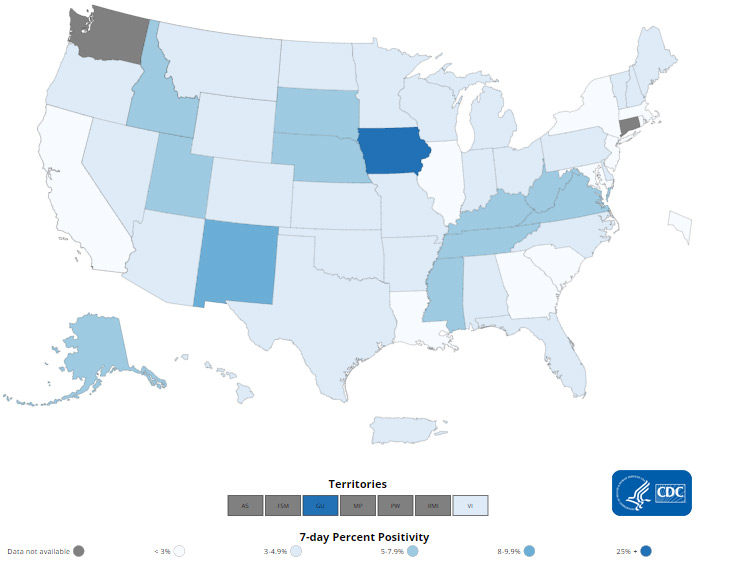Recommendations for Fully Vaccinated People
COVID-19 Homepage
Protect Those at Risk
Interpretive Summary for March 11, 2022
Protect Those at Risk
At this point in the pandemic, many people are at much lower risk of severe illness, hospitalization, and death from COVID-19. Vaccination and testing levels are high, treatments are more advanced and widely available, and the population has increased immunity through vaccination or previous infection. While low community risk is welcome news, we know that low risk does not mean no risk. Some people and places are still at high risk for serious illness, and they face challenging decisions.
Who is most likely to become very sick or die from COVID-19? Your chances increase with age and underlying medical conditions like cancer, diabetes, heart conditions, dementia, and obesity, particularly if you’re not up to date on vaccinations. People with weakened immune systems,* some disabilities, some mental health conditions, and some chronic diseases are also at higher risk. A lot of people might not know they’re at risk for severe illness—review the list to find out if you could be.
COVID-19 Community Levels can help people protect themselves and navigate this new phase of the pandemic. If you are at high risk, make sure you’re up to date on your COVID-19 vaccines and wear a well-fitting mask indoors in areas with medium or high COVID-19 Community Levels. If someone you visit with is at high risk, take a rapid test right before a visit. Staying outside is always safest, but if the visit is indoors, make sure the ventilation is good and consider wearing a well-fitting mask. People at high risk, and the whole community, can be safe only when we all protect each other.
*People who are moderately or severely immunocompromised have specific COVID-19 vaccine recommendations for the primary series and booster dose due to their different immune response following COVID-19 vaccination. For more information, visit CDC’s website.
Note to Readers: COVID-19 Community Levels do not apply in healthcare settings, such as hospitals and nursing homes. Instead, healthcare settings should continue to use community transmission rates and follow CDC’s infection prevention and control recommendations for healthcare workers.
- COVID Data Tracker’s homepage was updated and reorganized, making it easier to navigate and quickly locate COVID-19 data.
- COVID Data Tracker’s Hospitalizations by Vaccination Status – COVID-NET tab was updated to include the 5–11 years age group.
- COVID Data Tracker’s Trends in Cases and Deaths by Race/Ethnicity, Age, and Sex tab was updated to display case and death rates by age group and race/ethnicity at the national and regional level.
- Disparities in COVID-19 Vaccination Coverage Between Urban and Rural Counties — United States, December 14, 2020–January 31, 2022
- SARS-CoV-2 Incidence in K–12 School Districts with Mask-Required Versus Mask-Optional Policies — Arkansas, August–October 2021
- COVID-19 Vaccine Provider Access and Vaccination Coverage Among Children Aged 5–11 years — United States, November 2021–January 2022
Reported Cases
As of March 9, 2022, the current 7-day moving average of daily new cases (37,147) decreased 28.8% compared with the previous 7-day moving average (52,156). A total of 79,248,406 COVID-19 cases have been reported in the United States as of March 9, 2022.
Currently two variants, Omicron and Delta, are classified as Variants of Concern (VOC) in the United States. CDC Nowcast projections* for the week ending February 26, 2022, estimate the combined national proportion of lineages designated as Omicron to be 100%. There are five lineages designated as Omicron: B.1.1.529, BA.1, BA.1.1, BA.2, and BA.3. COVID Data Tracker now shows the proportions of the B.1.1.529 lineage (includes BA.1 and BA.3), BA.1.1** lineage, and the BA.2 lineage. The predominant Omicron lineage in the United States is BA.1.1, which is descendent of the BA.1 lineage and is characterized by an additional substitution (R346K) in the spike protein. The national proportion of BA.1.1 is projected to be 73.7% (95% PI 70.1-77.0%). B.1.1.529 (BA.1 and BA.3) is projected to be 14.7% (95% PI 12.4-17.4%) and BA.2 is projected to be 11.6% (95% PI 9.8-13.6%). Delta is projected to continue to be 0.0% (95% PI 0.0-0.0%). Omicron is predicted to be 100% in all HHS regions.
79,486,762
Total Cases Reported
79,486,762
Total Cases Reported
30,040
Current 7-Day Average**
30,040
Current 7-Day Average**
36,010
Prior 7-Day Average
36,010
Prior 7-Day Average
-16.6%
Change in 7-Day Average since Prior Week
-16.6%
Change in 7-Day Average since Prior Week
*The median time from specimen collection to sequence data reporting is about 3 weeks. As a result, weighted estimates for the most recent few weeks may be unstable or unavailable. CDC’s Nowcast is a data projection tool that helps fill this gap by generating timely estimates of variant proportions for variants that are circulating in the United States. View Nowcast estimates on CDC’s COVID Data Tracker website on the Variant Proportions page.
**For national data, the proportion of BA.1.1 is shown separately. For regional data, the proportion of BA.1.1 is also aggregated with B.1.1.529.
***Historical cases are excluded from daily new cases and 7-day average calculations until they are incorporated into the dataset for the applicable date. Of 457,051 historical cases reported retroactively, 5,837 were reported in the current week and 27,211 were reported in the prior week.
Vaccinations
The U.S. COVID-19 Vaccination Program began December 14, 2020. As of March 9, 2022, 555.9 million vaccine doses have been administered in the United States. Overall, about 254.3 million people, or 76.6% of the total U.S. population, have received at least one dose of vaccine. About 216.4 million people, or 65.2% of the total U.S. population, have been fully vaccinated.* About 95.5 million additional or booster doses have been reported in people who have been fully vaccinated; however, 49.9% of the total booster-eligible population has not yet received a booster dose. As of March 9, 2022, the 7-day average number of administered vaccine doses reported (by date of CDC report) to CDC per day was 302,787, a 11.9% decrease from the previous week.
CDC’s COVID Data Tracker Vaccination Demographic Trends tab shows vaccination trends by age group and by race/ethnicity. As of March 9, 2022, 95.0% of people ages 65 years or older have received at least one dose of vaccine and 88.8% are fully vaccinated. For people ages 5–11 years, only 26.5% are fully vaccinated. For people ages 5 years or older, 81.4% have received at least one dose of vaccine and 69.3% are fully vaccinated. Of the fully vaccinated population, people ages 75 years or older have the highest proportion of additional/booster doses (68.9%) while people ages 12–17 have the lowest proportion (22.0%).
As of March 9, 2022, of all race/ethnicity groups, the Asian non-Hispanic population has the highest proportion that is fully vaccinated (60.1%), and the Black non-Hispanic population has the lowest proportion that is fully vaccinated (41.0%). Of the fully vaccinated population, the Asian non-Hispanic population has the highest proportion of additional/booster doses (66.5%), while the Hispanic/Latino population has the lowest proportion (39.7%).
COVID Data Tracker’s COVID-19 Vaccination Equity tab shows vaccination trends by urban/rural status. As of March 9, 2022, 48.7% of people in rural counties are fully vaccinated, while the range of vaccination coverage in the 4 urban/metro counties ranged from 52.6% (micropolitan) to 66.4% (large central metro).
557,644,629
Vaccine Doses Administered
557,644,629
Vaccine Doses Administered
254,750,626
People who received at least one dose
254,750,626
People who received at least one dose
216,829,829
People who are fully vaccinated*
216,829,829
People who are fully vaccinated*
76.7%
Percentage of the U.S. population that has received at least one dose
76.7%
Percentage of the U.S. population that has received at least one dose
65.3%
Percentage of the U.S. population that has been fully vaccinated*
65.3%
Percentage of the U.S. population that has been fully vaccinated*
+0.1
Percentage point increase from last week
+0.1
Percentage point increase from last week
+0.1
Percentage point increase from last week
+0.1
Percentage point increase from last week
*Represents the number of people who have received the second dose in a two-dose COVID-19 vaccine series (such as the Pfizer or Moderna vaccines) or one dose of the single-shot Johnson & Johnson’s Janssen vaccine.
Hospitalizations
New Hospital Admissions
The current 7-day daily average for March 2–8, 2022, was 3,113. This is a 27.5% decrease from the prior 7-day average (4,293) from February 23–March 1, 2022.
4,558,964
Total New Admissions
4,558,964
Total New Admissions
3,113
Current 7-Day Average
3,113
Current 7-Day Average
4,293
Prior 7-Day Average
4,293
Prior 7-Day Average
-27.5%
Change in 7-Day Average
-27.5%
Change in 7-Day Average
The start of consistent reporting of hospital admissions data was August 1, 2020.
Daily Trends in Number of New COVID-19 Hospital Admissions in the United States

New admissions are pulled from a 10 am EST snapshot of the HHS Unified Hospital Timeseries Dataset. Due to potential reporting delays, data from the most recent 7 days, as noted in the figure above with the grey bar, should be interpreted with caution. Small shifts in historic data may also occur due to changes in the Centers for Medicare and Medicaid Services (CMS) Provider of Services file, which is used to identify the cohort of included hospitals.
Hospitalization Rates by Vaccination Status in Adults
CDC’s Coronavirus Disease 2019-Associated Hospitalization Surveillance Network (COVID-NET) shows that the monthly rate of COVID-19-associated hospitalizations in January 2022 among children ages 5–11 years was 3 times as high in unvaccinated children compared to children who are fully vaccinated with a primary vaccine series.
Weekly Rates of COVID-19-Associated Hospitalization among Children Ages 5–11 Years, by Vaccination Status

The Coronavirus Disease 2019 (COVID-19)-Associated Hospitalization Surveillance Network (COVID-NET) is an additional source for hospitalization data collected through a network of more than 250 acute-care hospitals in 14 states (representing ~10% of the U.S. population). Detailed data on patient demographics, including race/ethnicity, underlying medical conditions, medical interventions, and clinical outcomes, are collected with a standardized case reporting form.
Deaths
The current 7-day moving average of new deaths (1,180) has decreased 25.0% compared with the previous 7-day moving average (1,572). As of March 9, 2022, a total of 961,620 COVID-19 deaths have been reported in the United States.
965,575
Total Deaths Reported
965,575
Total Deaths Reported
1,052
Current 7-Day Average*
1,052
Current 7-Day Average*
1,188
Prior 7-Day Average
1,188
Prior 7-Day Average
-11.4%
Change in 7-Day Average Since Prior Week
-11.4%
Change in 7-Day Average Since Prior Week
*Historical deaths are excluded from the daily new deaths and 7-day average calculations until they are incorporated into the dataset by their applicable date. Of 20,882 historical deaths reported retroactively, none were reported in the current week; and none were reported in the prior week.
Daily Trends in Number of COVID-19 Deaths in the United States Reported to CDC

7-Day moving average
 More Death Data
More Death DataTesting
The percentage of COVID-19 NAATs (nucleic acid amplification tests)* that are positive (percent positivity) is decreasing in comparison to the previous week. The 7-day average of percent positivity from NAATs is now 2.8%. The 7-day average number of tests reported for February 25– March 3, 2022, was 948,207 down 7.0 % from 1,019,890 for the prior 7 days.
834,241,390
Total Tests Reported
834,241,390
Total Tests Reported
858,144
7-Day Average Tests Reported
858,144
7-Day Average Tests Reported
2.2%
7-Day Average % Positivity
2.2%
7-Day Average % Positivity
2.8%
Previous 7-Day Average % Positivity
2.8%
Previous 7-Day Average % Positivity
-0.59
Percentage point change in 7-Day Average % Positivity since Prior Week
-0.59
Percentage point change in 7-Day Average % Positivity since Prior Week
*Test for SARS-CoV-2, the virus that causes COVID-19




